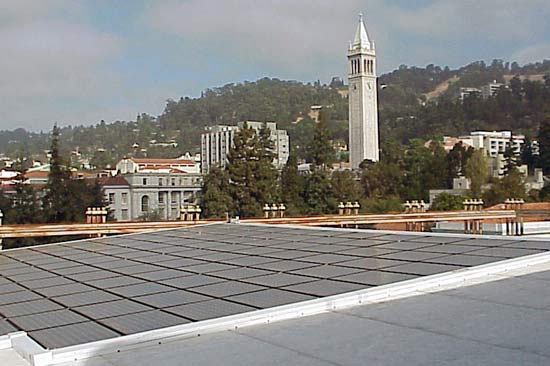 Solar panels installed on the roof of the Martin Luther King Jr. Student Union have helped lower the campus's energy costs. Innovations such as this will help Berkeley attain its carbon-reduction goals on schedule. (Bonnie Azab Powell photo)
Solar panels installed on the roof of the Martin Luther King Jr. Student Union have helped lower the campus's energy costs. Innovations such as this will help Berkeley attain its carbon-reduction goals on schedule. (Bonnie Azab Powell photo)Berkeley moves toward climate neutrality
Two years after launch of the campus's climate-action plan, the keyword is 'action.' A new report outlines next steps
09 April 2009
BERKELEY — In 2007, the campus launched an ambitious plan to sharply reduce its greenhouse-gas emissions, aiming to cut back to 1990 levels by 2014 — faster than required by both California law and UC policy — on the road to the goal of "climate neutrality."
A just-released report by the Climate Action Partnership and the Office of Sustainability documents the steps Berkeley has taken the past two years to implement that plan, the CalCAP Feasibility Study, and outlines others under consideration.
"While it is quite satisfying to see the progress we've made since 2007, our work is not done," says Vice Provost Cathy Koshland, Chair of the CalCAP Steering Committee. "The campus continues to investigate additional projects — like improved efficiencies in the steam-delivery system or larger-scale renewable-energy installations — to ensure we meet our 2014 target."
The highlight of the new 28-page report is the campus's 2009-11 Strategic Energy Plan, which en-compasses a number of efforts already under way — among them, 200 energy-efficiency projects, a refrigerator and CRT monitor replacement program, and expansion of computer power-management systems for networked computers. The SEP projects, with an estimated price tag of $25 million — about a third of which will be paid by rebates from PG&E — could reduce campus energy costs by as much as $5 million a year.
Other ongoing emission-reduction projects described in the report include installation of on-site solar panels on campus facilities, reduction of fuel usage by the campus fleet and commuters, and education programs aimed at changing behavior. The campus, for example, has been adding electric vehicles to its fleet, while decreasing its overall size. At the same time, a recent survey showed an increase in bicycle commuting by Berkeley students, and a decrease in students driving alone.
The steps outlined in the report are expected to account for about half of the emission reductions needed to meet the campus's 2014 target, and represent a substantial step toward the ultimate goal of "climate neutrality." UC policy defines climate neutrality — which the university is committed to achieve "as soon as possible" — as "a net zero impact on the Earth's climate," to be achieved "by minimizing GHG (greenhouse-gas) emissions as much as possible and using carbon offsets or other measures to mitigate the remaining GHG emissions."
The campus's Climate Action Plan is online at sustainability.berkeley.edu/calcap.

